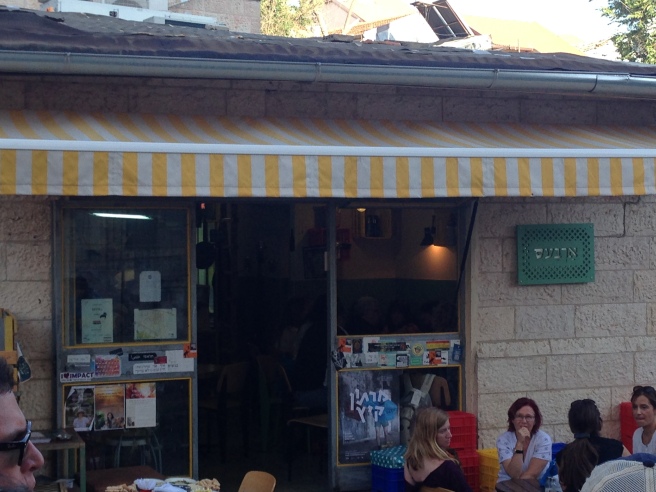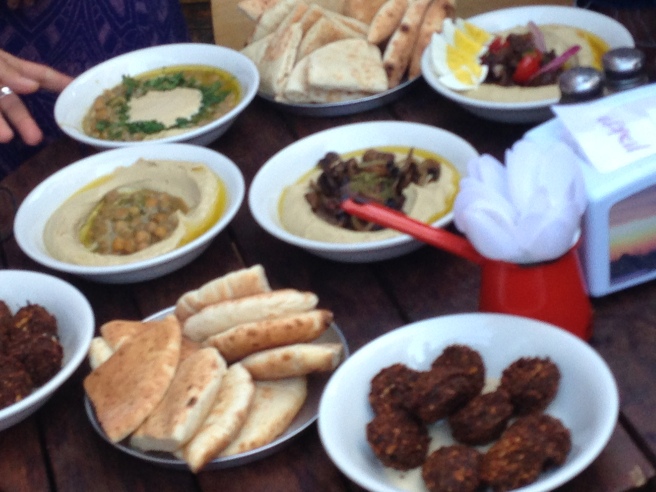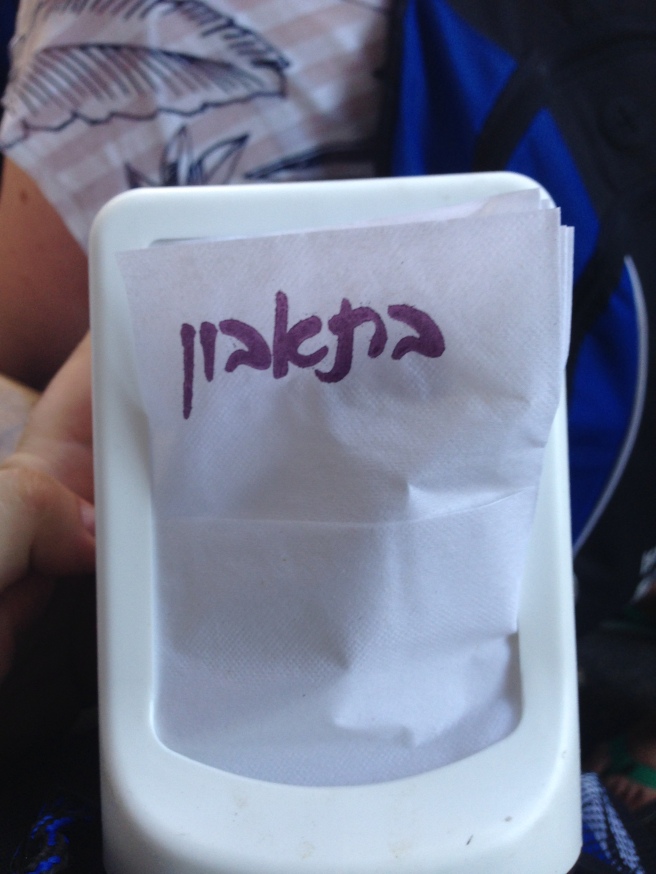I would be very remiss if I were to only focus on restaurants in Israel. Throughout the small country, there are many, many outdoor markets or “the shuk.”
 One of the most well-known markets in Israel is Machane Yehuda in Jerusalem. The market has over 250 vendors and sells everything from fresh fruit, vegetables, nuts, spices, meat, fish, cheese, breads, pastries, and more. It’s a cornucopia of smells, textures, flavors, sights, and beautiful food scenery—food porn really.
One of the most well-known markets in Israel is Machane Yehuda in Jerusalem. The market has over 250 vendors and sells everything from fresh fruit, vegetables, nuts, spices, meat, fish, cheese, breads, pastries, and more. It’s a cornucopia of smells, textures, flavors, sights, and beautiful food scenery—food porn really.



 My trip was lucky enough to go on a culinary tour of Machane Yehuda, and have a fabulous guide—or madrich in Hebrew. Residents of Jerusalem come to this market from all over the city in order to do their shopping for the week, and on Thursdays and Fridays it gets super crowded with all the people doing their shopping for Shabbat. In fact, on Friday afternoon there is a bugle that plays to signify the market is closing for the Jewish Sabbath. Our guide gave us a funny anecdote on the market as well: How do you know if a woman is married, has children, etc., in the market? On Wednesdays the grandmothers shop since they have lots of requests from their grandchildren for special treats, on Thursdays it’s the mothers since they cook all day Friday, Friday morning it’s the married women, so they can cook Friday afternoon, and Friday afternoon it’s the single women since they forget to cook until the last minute 😉
My trip was lucky enough to go on a culinary tour of Machane Yehuda, and have a fabulous guide—or madrich in Hebrew. Residents of Jerusalem come to this market from all over the city in order to do their shopping for the week, and on Thursdays and Fridays it gets super crowded with all the people doing their shopping for Shabbat. In fact, on Friday afternoon there is a bugle that plays to signify the market is closing for the Jewish Sabbath. Our guide gave us a funny anecdote on the market as well: How do you know if a woman is married, has children, etc., in the market? On Wednesdays the grandmothers shop since they have lots of requests from their grandchildren for special treats, on Thursdays it’s the mothers since they cook all day Friday, Friday morning it’s the married women, so they can cook Friday afternoon, and Friday afternoon it’s the single women since they forget to cook until the last minute 😉



 To start off our culinary tour, our guide went into the market and brought out some traditional appetizers and snacks sold throughout the shuk. Kibbeh, also sometimes known as kubbeh are football-shaped croquettes made of bulgar wheat, stuffed with minced lamb or beef, and baked. It has a thick skin that keeps the meat inside moist and delicious. It is often served with tahini to dip, and a staple dish in many Middle Eastern countries. The next treat for us to sample were cigars, which are not tobacco, but get their inspiration from it—they somewhat resemble cigarettes and consist of ground meat or potatoes rolled inside phyllo dough that’s then deep-fried. Though it sounds very heavy, it’s actually light and delicious. They have a nice kick of spice as well. The final pre-tour sample was stuffed grape leaves. The grape leaves are a vegetarian option and are filled with a mediterranean rice mixed with herbs, lemon, garlic, and other spices. They have a briny quality, very acidic and has a wonderful cleansing quality for the palette.
To start off our culinary tour, our guide went into the market and brought out some traditional appetizers and snacks sold throughout the shuk. Kibbeh, also sometimes known as kubbeh are football-shaped croquettes made of bulgar wheat, stuffed with minced lamb or beef, and baked. It has a thick skin that keeps the meat inside moist and delicious. It is often served with tahini to dip, and a staple dish in many Middle Eastern countries. The next treat for us to sample were cigars, which are not tobacco, but get their inspiration from it—they somewhat resemble cigarettes and consist of ground meat or potatoes rolled inside phyllo dough that’s then deep-fried. Though it sounds very heavy, it’s actually light and delicious. They have a nice kick of spice as well. The final pre-tour sample was stuffed grape leaves. The grape leaves are a vegetarian option and are filled with a mediterranean rice mixed with herbs, lemon, garlic, and other spices. They have a briny quality, very acidic and has a wonderful cleansing quality for the palette.


 The next stop on our tour was for the #1 food of Israel—Hummus! Waiting for us at a small cafe across from one of the entrances to the market was a table filled with a variety of hummus and hummus-themed dishes. One of the plates had sautéed mushrooms, one with fresh chickpeas, one studded with roasted garlic, a bowl of tahini and a plate of fresh, hot, crispy falafel and more. The falafel balls, especially, were fresh from the fryer and even though they burnt the roof of my mouth a bit, they were soft and pillowy on the inside and a crunch while biting into the outer coating.
The next stop on our tour was for the #1 food of Israel—Hummus! Waiting for us at a small cafe across from one of the entrances to the market was a table filled with a variety of hummus and hummus-themed dishes. One of the plates had sautéed mushrooms, one with fresh chickpeas, one studded with roasted garlic, a bowl of tahini and a plate of fresh, hot, crispy falafel and more. The falafel balls, especially, were fresh from the fryer and even though they burnt the roof of my mouth a bit, they were soft and pillowy on the inside and a crunch while biting into the outer coating.


 We next stopped at an Eastern European cafe further into the market area for some khachapuri. Khachapuri is a traditional Georgian (the country, not the state) snack of cheese filled bread. This dish is so popular among Georgian people that it is sometimes believed to be more popular than pizza, and is, at times, used to measure inflation—similar to the butter and guns model in Keynesian economics. The stuffed bread is cooked in a pizza/laffa oven, which makes it chewy, but also slightly charred with a nice crisp crust. We also sampled a khachapuri filled with beans as well. While not as popular as the cheese version, it was tasty as well.
We next stopped at an Eastern European cafe further into the market area for some khachapuri. Khachapuri is a traditional Georgian (the country, not the state) snack of cheese filled bread. This dish is so popular among Georgian people that it is sometimes believed to be more popular than pizza, and is, at times, used to measure inflation—similar to the butter and guns model in Keynesian economics. The stuffed bread is cooked in a pizza/laffa oven, which makes it chewy, but also slightly charred with a nice crisp crust. We also sampled a khachapuri filled with beans as well. While not as popular as the cheese version, it was tasty as well.



 We then spent some more time walking around the market and had the opportunity to taste delicious, fresh juices and smoothies, homemade spice blends, zahtar flavored flatbread and also buy some fruit, cookies, and more gifts to take home.
We then spent some more time walking around the market and had the opportunity to taste delicious, fresh juices and smoothies, homemade spice blends, zahtar flavored flatbread and also buy some fruit, cookies, and more gifts to take home.
 One of the interesting place we passed towards one end of the market was Casino de Paris. It’s a new project that developed from an entrepreneur that already opened another coffee shop in the market and has been very successful in transforming parts of the market into modern, chic hotspots. Casino de Paris is open after the market closes, and there are other locations, including in London and Paris.
One of the interesting place we passed towards one end of the market was Casino de Paris. It’s a new project that developed from an entrepreneur that already opened another coffee shop in the market and has been very successful in transforming parts of the market into modern, chic hotspots. Casino de Paris is open after the market closes, and there are other locations, including in London and Paris.





 The final stop on our gastronomic journey was at Kingdom of Halva or Mamlechet Ha’Halva in Hebrew. Kingdom of Halva has multiple stalls around the market and is known as the place to buy halva in Jerusalem. Halva is a traditional, Jewish dessert usually made with some sort of nut butter, and most Israeli halva is made from tahini or sesame paste. Kingdom of Halva makes all of its halva varieties homemade, and uses a blend of 90% sesame paste made from whole grain, Ethiopian sesame seeds and 10% sugar. They have over 100 flavors available including, but not limited to: pistachio, Belgian chocolate, pecan, coffee, nougat, piña colada, and more. The halva here is so delicious. It has a nutty taste from the sesame, a non-cloying sweetness, and a slightly grainy texture that melts in your mouth. Another great thing about halva is that it can be stored at room temperature for most of the year and last for months. Kingdom of Halva also makes many varieties of tahini that can be used to make delicious falafel or hummus, as a condiment on Mediterranean sandwiches, as a dip for bread, or even eaten on its own.
The final stop on our gastronomic journey was at Kingdom of Halva or Mamlechet Ha’Halva in Hebrew. Kingdom of Halva has multiple stalls around the market and is known as the place to buy halva in Jerusalem. Halva is a traditional, Jewish dessert usually made with some sort of nut butter, and most Israeli halva is made from tahini or sesame paste. Kingdom of Halva makes all of its halva varieties homemade, and uses a blend of 90% sesame paste made from whole grain, Ethiopian sesame seeds and 10% sugar. They have over 100 flavors available including, but not limited to: pistachio, Belgian chocolate, pecan, coffee, nougat, piña colada, and more. The halva here is so delicious. It has a nutty taste from the sesame, a non-cloying sweetness, and a slightly grainy texture that melts in your mouth. Another great thing about halva is that it can be stored at room temperature for most of the year and last for months. Kingdom of Halva also makes many varieties of tahini that can be used to make delicious falafel or hummus, as a condiment on Mediterranean sandwiches, as a dip for bread, or even eaten on its own.

 Although our tour of the market was over, our guide surprised us with another treat to end the afternoon of Marzipan rugelach. Marzipan rugelach—as often assumed—do not actually have any marzipan in them, but rather are named since they were first made at the Marzipan Bakery in Jerusalem. These rugelach cookies differ from traditional rugelach, often flavored with cinnamon or raisins, with a flaky exterior, as they are filled with chocolate. In addition, marzipan rugelach are sticky, fudgy, intensely chocolatey, and have a cult following in Israel (and among many Jews around the world as well). They are super decadent with a wonderful richness, doughy and exceedingly sweet. They are almost like crack rugelach—they are that good and worth a trip to Jerusalem just to try these treats. What a perfect way to end our afternoon at Machane Yehuda market.
Although our tour of the market was over, our guide surprised us with another treat to end the afternoon of Marzipan rugelach. Marzipan rugelach—as often assumed—do not actually have any marzipan in them, but rather are named since they were first made at the Marzipan Bakery in Jerusalem. These rugelach cookies differ from traditional rugelach, often flavored with cinnamon or raisins, with a flaky exterior, as they are filled with chocolate. In addition, marzipan rugelach are sticky, fudgy, intensely chocolatey, and have a cult following in Israel (and among many Jews around the world as well). They are super decadent with a wonderful richness, doughy and exceedingly sweet. They are almost like crack rugelach—they are that good and worth a trip to Jerusalem just to try these treats. What a perfect way to end our afternoon at Machane Yehuda market.
 So I hope you’re inspired to go out and eat some tasty Israeli treats, or even take a trip to Jerusalem and visit the market yourselves! B’Teiavon and stay hungry!
So I hope you’re inspired to go out and eat some tasty Israeli treats, or even take a trip to Jerusalem and visit the market yourselves! B’Teiavon and stay hungry!
















Impressive post! Great that you took so much care to describe “everything”. Thanks.
LikeLike
Thank you 🙂
LikeLike